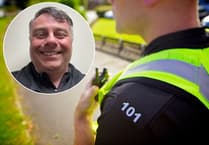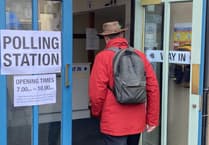THE fascinating history of a small West Devon village has now been put down in black and white in Black Torrington: The Second Millennium, 1001-2000.
The author of the village history is Black Torrington?s former rector Gerry Matthews, who delves into some interesting stories from the village?s past.
There is some dispute about the derivation of the name Black Torrington which made its first appearance in the Pipe Rolls ? the Exchequer records ? of 1167 when it is called ?Blacktoriton?.
Mr Matthews supports the theory advanced by Thomas Westcote in his View of Devonshire in around 1630, in which he writes: ?Black Torrington took his forename of the soil of the river.? Mr Matthews says as the bed of the River Torridge which forms the northern boundary of the parish has many black stones along this part of its course, this would seem the most credible origin of the name.
Another theory is that the name might have come from the Saxon lord, Edmar the Black, however, the Edmar who held Torintona at the death of Edward the Confessor was not the ?Black? and the Torintona in question was not in fact Black Torrington.
An alternative theory was that it was ?Blake?s Torrington? because of a spelling in the Pipe Roll of 1210 and the Fees Roll of 1219 which read ?Blake torrinton? but Blake has never been identified as a person.
The book covers the medieval history of the parish church ?which stands at 385 feet above sea level ? manor and hundred as well as detailing social history in a rural community.
Mr Matthews devotes chapters to the well-known families of the village in the 16th century, including the Braunds and the Cohams; the Stuart and Civil War era and the village during the 19th century.
In a chapter on the village inns, Mr Matthews tells the story of a song celebrating the role of the Union Inn (now the Torridge Inn) in a memorable election victory in 1830.
It was written by John Madge of Highampton for the Devon county elections of that year, following the death of George IV. The song revolves around the electioneering by the Rev William Bickford Coham and his brother George on behalf of the Whig, Lord Ebrington ? the son of Earl Fortescue ? and Sir Thomas Acland against the Tory, Mr Edmund Bastard, of Kitley.
One verse of this song runs as follows:
?When they came into Black Torrington
Such a sight was never seen,
To see those Votes take breakfast,
All at the Union Inn,
Parson Coham was so delighted,
He to the Votes did say,
?Sir Thomas and Lord Ebrington
I hope will gain the day,?
Lord Ebrington came top of the poll, with Sir Thomas Acland a close second.
Mr Matthews also tells the dramatic story of a shooting on the Chila Road in 1907. Two young women Alice Ivey and Maud Slade were walking home to the village on a Sunday evening in February after attending Chila Chapel, they were accompanied by Alice?s two younger sisters. As they neared Fraunch Gate, they were passed by 21-year-old Robert Lamble, who lived with his grandparents at Ley Court.
Shortly afterwards, a shot was fired, and the terror-struck girls screamed and ran, becoming separated into pairs. Both older girls had been sprayed with gun shot. Robert Lamble came from behind a hedge and struck Maud in the back with a knife. The assailant then caught up Alice and attacked her with a knife and the butt of his gun and left her as she collapsed unconscious.
When she recovered, she staggered homewards alone, until she was met by her father and Mr Slade. It was by then nearly 10pm. Doctor George Candler was called and PC Kite, who was on duty outside the Union Hotel received the news and proceeded on his bicycle.
Arriving at Ley Farm, Mr Lamble senior came down from bed and let the constable into the kitchen. There, his grandson, unbeknown to him, was sitting with the gun. PC Kite pushed the gun aside as it was fired and the shot into the wall. The policeman grappled with the gunman and handcuffed him. He was taken to Holsworthy Police Station and in the morning was charged of shooting with intent to murder.
Apparently Robert Lamble had wanted to court Mrs Ivey, but had not been encouraged by the young lady!
Mr Matthews is well-qualified to write a village history of Black Torrington having serving as Priest-in-charge of Black Torrington, from 1978 until retiring from stipendiary ministry in 1990.
He was born in Bridgwater in Somerset in 1931, and was educated at West Buckland School in North Devon before reading law at Bristol University.
After National Service, Mr Matthews studied for ordination at Ripon Hall, Oxford, and was made Deacon by the Bishop of Birmingham in 1957.
He returned to the West Country as Vicar of Brent Tor in 1963 before taking up the post at Black Torrington 25 years ago.
One of the most interesting chapters in the book is the section on Black Torrington during war times.
There was only one major incident in the village during the Second World War, which happened in 1940, when a German bomber being chased by the RAF dropped a stick of bombs by Gorford and Kingsley.
Mrs Broad was injured in the leg by flying shrapnel, a hole was made in the road to Bridge and half a dozen incendiary bombs threatened a hay store in the village.
The army came to the village for two months from August 1940. A detachment of the ?Oxs and Bucks? regiments ? Oxford and Bucks Light Infantry ? was billeted at the Rectory barn and stables and in the glebe field behind.
The 160-page book is clearly well-researched and recounts a number of marvellous stories.
The book is Illustrated with nearly 100 picture postcards and collected photographs dating from the beginning of he century to more modern snapshots.
Black Torrington: The Second Millennium, 1001-2000 by Gerry Matthews is published by Edward Gaskell publishers.



